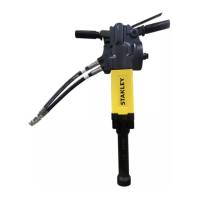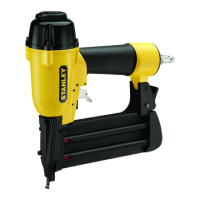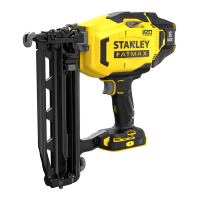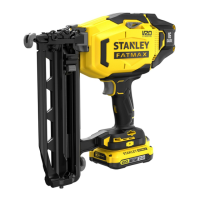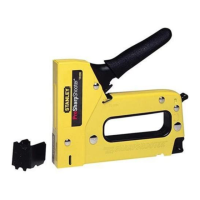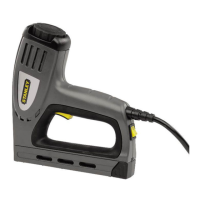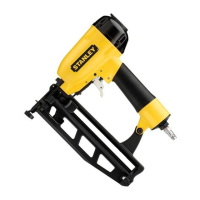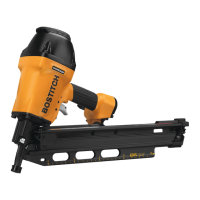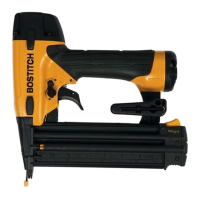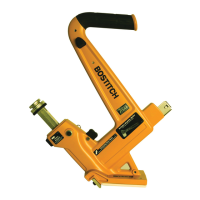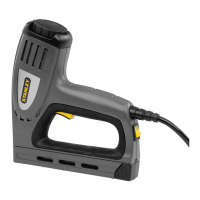INSTALLATION PROCEDURE / ADJUSTMENTS
(cont.)
Pusher Spring
1. Attach spring (#63) in uncoiled position to pusher (#55)
using roll pin (#64).
2. Insert slotted spring bolt (#57) through spring spool bracket.
3. Align spring end with hole in spring spool bracket and pass
end of spring through bolt slot.
4. Pull pusher to the end of the magazine and clamp spring.
5. Using an Allen wrench, turn slotted bolt to wind spring
until coil is completely tight.
6. Tighten spring bolt and Flexlock nut.
Throttle valve
Follow these steps after completing tool assembly in order to
minimize the time and effort required for optimum throttle valve
adjustment:
1. Using the valve stem, slowly screw in the front valve seat
(#48) until it bottoms, then back it out 1-1/2 turns.
2. Do the same with the rear valve seat (#5).
3. Attach an air line and fully depress the trigger. AIR
SHOULD LEAK OUT THE REAR VALVE SEAT. While
depressing the trigger, slowly turn in the rear valve seat
(#5) until the air stops leaking.
4. Release the trigger. AIR SHOULD LEAK OUT OF THE
HANDLE. Place a 3/16 wrench on the trigger valve stem
(#47) and turn the front valve seat (#48) in slowly until the
air stops leaking from the handle.
5. Gently depress the trigger. Air should flow evenly from the
rear exhaust to the handle exhaust.
6. The valve should now be adjusted - test the tool
7. Tighten the front and rear valve seat locking set screws
(#19) and re-test the tool.
8. Do not loosen or tighten center locking set screw (#19) it
is pre-set from Spenax.
9. Do not screw set screw (#1) in too far or it will result in the
tool running sluggish by restricting the air flow.
TOOL LEAKS AIR OR IS SLUGGISH
1. If tool is leaking air in the throttle area, see “Throttle Valve
Adjustment” section.
2. Should the tool leak air in both the triggered and rest
positions, a damaged piston o-ring may be the cause. Once
the piston o-ring has been replaced, lubricate with lithium
grease. Tilt the front of the tool to one side to allow the o-
ring on the piston to pass the notch on the cylinder liner. If
this procedure is not followed, the o-ring may be damaged
during the insertion of the piston assembly into the cylinder
housing.
3. If the tool still continues to leak, the liner may be leaking
between the housing. The tool should be sent back to
Spenax for repair.
4. In the event the rear throttle valve screw is turned in too far,
the tool will operate slowly or in a sluggish manner during
the opening/loading sequence. This screw controls the
amount of rear exhaust. When properly adjusted, two or
three threads should be exposed once the nut and washer are
in place.
LUBRICATION
1. The “SC” series Flex-C tools are designed for long, trouble-
free service with minimal air line lubrication. (If an in-line
lubricator is used, it should be set at the minimum rate of
flow.)
2. Excess oil in the tool will attract dirt, lint, and the adhesive
material used in collating the fasteners, preventing smooth
operation. When lubrication is used, always use a good
grade of 5W non-detergent oil with no additives.
3. When servicing or repairing tool use lithium grease on all
moving parts.
FILTER AND REGULATOR
1. The air line should always contain a filter and regulator unit
to provide the tool with a constant flow of clean, dry air. If
moisture and contaminates are allowed to enter the tool, the
tool’s serviceable life will be decreased.
2. The regulator should be set between 100 and 105 psi. (6.90
- 7.24 bar). Never operate this tool beyond 115 psi. (7.93
bar).
TIPS ON EXTENDING TOOL LIFE
The serviceable life of the “SC” series tools can be extended
greatly by using the following guidelines:
1. Always use Stanley Spenax brand fasteners. Never replace
worn or broken parts with anything other than genuine
Stanley Spenax parts. Generic fasteners may shorten the
life of your Flex-C tool and will void the manufacturer’s
warranty.
2. Keep your tool(s) clean and dry. Always use clean, dry air
and never exceed the recommended air pressure noted
above.
3. Use of this tool at minimum air pressure required for the
work at hand will greatly extend the life of the tool.
4. Exercise caution not to drop equipment. Tools dropping
onto the floor or ground is a primary reason for parts
replacement.
HELPFUL HINTS FOR FIELD SERVICE TOOL JAMS
1. The most common reason for jamming problems in the SC
tool is operator error. Because of the tool’s valve unit, the
trigger must be pulled completely to the rear to ensure
positive functioning of the valve. If the tool is “short
cycled,” the feed mechanism will return forward
prematurely in an attempt to pick up a second ring. This
will most likely cause a jam.
2. If a jam occurs, pull pusher back and remove remaining
rings from magazine. Point tool away from yourself and
others, and cycle tool slowly. This should force jammed
ring(s) out of jaw mechanism.
3. If procedure “2” does not clear the tool, disconnect air, lay
tool on a clean flat surface and remove top jaw bolt and nut,
and pull top jaw and bushing from tool. Jammed rings are
now exposed and may be removed from tool. Remove
build up of dirt, lint, and any other foreign debris and check
for worn or damaged parts. Re-assemble in reverse order.
4. Replace worn or damaged parts to keep tool operating
properly.
5 of 6 01/03

